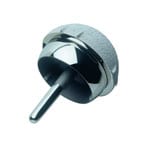AAOS Demystifies Metal on Metal Hips
The American Academy of Orthopaedic Surgeons (AAOS) recently published an “information statement” for patients who have been affected by the recent metal-on-metal (MoM) hip disaster. The statement is not a rigorous academic analysis of the current situation with MoM hips, but it does provide a fantastic resource for patients who have questions about their own MoM hip.
The statement begins with a short history of why MoM hips were reintroduced to the medical marketplace in over the last two decades. At first, MoM hips were found to have lower wear rates than metal-on-polyethylene hips. Wear induced osteolysis, or the process that typically causes implant loosening or fracture, is a major concern for the orthopedic industry. It was thought that MoM hips could solve a major problem presented by polyethylene bearing surfaces – decreased wear rates would mean longer lasting hips and less revision surgeries over a lifetime. Since 1996, more than 1 million MoM hips have been implanted worldwide for this reason. Sadly, data from national joint registries has shown the failure rate of MoM hips to be 2-3 times higher than hips with polyethylene or ceramic bearing surfaces.
So what happens when a MoM hip fails? Well, the patient usually experiences severe pain in their affected hip. This pain is usually caused by something known as “adverse local tissue reaction” (ALTR) or “aseptic lymphocytic vasculitis-associated lesions” (ALVAL) though there are a number of different possible reasons for pain with MoM implants – both extrinsic (something outside of the hip implant) and intrinsic (something wrong in the hip implant).
That’s why a clinical evaluation of your condition by an orthopedic surgeon is important to getting a correct diagnosis. They’ll look at your complete history to understand the root cause of your pain. A radiographic evaluation will also be integral to a correct diagnosis. Many orthopedic doctors are now using MRI with MARS imaging in order to see wear particles (the metal particles released by the hip when two pieces of metal rub against one in other with friction) and diagnose metallosis. Sometimes a doctor will prescribe a blood test for cobalt and chrome – the two metals typically used in MoM hip implants. Titanium testing is also becoming much more common. If you suspect metal poisoning from your MoM hip, we recommend asking your doctor if testing all three metals might be a good idea.
Finally, the AAOS recommends that all patients with MoM implants visit their doctors annually. Symptomatic or high risk patients (pain, gait changes, large diameter heads, high metal ion tests, recalled implant, etc.) should see their doctors every four to six months. The AAOS also recommends that orthopaedic surgeons prescribe repeat testing (MARS MRI, metal ion testing) on a regular basis for these patients.
The AAOS concludes their information statement with the incredibly important statement of “There should be a low threshold to perform a systematic evaluation of patients with MoM hip arthroplasty as early recognition and diagnosis will facilitate the initiation of appropriate treatment prior to significant adverse biological reactions.” Basically, it’s very important to monitor your MoM implant. If your surgeon doesn’t think so, then perhaps you should find a different one. Metal on metal hips can wreak havoc on a body – and your orthopedic surgeon should be aware of all possible damage to the one body you have.
Share This



